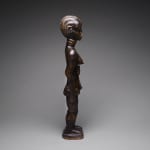Djimini Wooden Sculpture of a Woman, 20th Century CE
Wood
57.1 x 13.3 cm
22 1/2 x 5 1/4 in
22 1/2 x 5 1/4 in
PF.6309
Further images
Many African tribes preferred to think of the spirits of their ancestors collectively rather than in terms of separate individuals. This is the result of the animism that underlies their...
Many African tribes preferred to think of the spirits of their ancestors collectively rather than in terms of separate individuals. This is the result of the animism that underlies their religious beliefs. Such religious beliefs have been termed “animism” because they believed that a spirit exists in every living thing. Spirits dwell in the earth, in rivers and lakes, in the rain, in the sun and moon; still others demand to be appeased in order to promote fertility or cure disease. Their dwelling places may be given the shape of human figures, such as this glorious fertility sculpture depicting a standing woman. In this case, such spirits sometimes achieve enough of a stable identity to be viewed as rudimentary deities. Like many other neighboring tribes from the Ivory Coast, the Djimini (also spelled Dyimini) people believed that the spirits of the deceased continued to play an active role in the life of their descendants. By creating memorial sculptures and presenting it with proper sacrifices and libations, the relatives of the deceased could influence the favor of the spirit. Judging by the beauty and social position of this woman, there is no doubt that she would have continued to play a major role within society even after her bodily departure. She holds on hand on top of her belly while the other rests comfortably at her side. Her hair has been intricately woven into a series of braided crests that accentuate her beauty. Decorative scarification, considered both beauty marks and signs of rank, cover much of her face as well as her stomach. The series of three scars that fan out from the corner of her lips are uniquely Djimini. This gorgeous sculpture is the idealized form of feminine beauty that honors the ancestors of the past so that they might beneficially influence the future of the family and the tribe as a whole.







